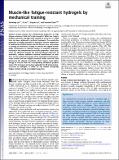| dc.contributor.author | Lin, Shaoting | |
| dc.contributor.author | Liu, Ji | |
| dc.contributor.author | Liu, Xinyue | |
| dc.contributor.author | Zhao, Xuanhe | |
| dc.date.accessioned | 2020-03-24T21:38:19Z | |
| dc.date.available | 2020-03-24T21:38:19Z | |
| dc.date.issued | 2019-05 | |
| dc.identifier.issn | 0027-8424 | |
| dc.identifier.issn | 1091-6490 | |
| dc.identifier.uri | https://hdl.handle.net/1721.1/124304 | |
| dc.description.abstract | Skeletal muscles possess the combinational properties of high fatigue resistance (1,000 J/m2), high strength (1 MPa), low Young's modulus (100 kPa), and high water content (70 to 80 wt %), which have not been achieved in synthetic hydrogels. The muscle-like properties are highly desirable for hydrogels' nascent applications in load-bearing artificial tissues and soft devices. Here, we propose a strategy of mechanical training to achieve the aligned nanofibrillar architectures of skeletal muscles in synthetic hydrogels, resulting in the combinational muscle-like properties. These properties are obtained through the training-induced alignment of nanofibrils, without additional chemical modifications or additives. In situ confocal microscopy of the hydrogels' fracturing processes reveals that the fatigue resistance results from the crack pinning by the aligned nanofibrils, which require much higher energy to fracture than the corresponding amorphous polymer chains. This strategy is particularly applicable for 3D-printed microstructures of hydrogels, in which we can achieve isotropically fatigue-resistant, strong yet compliant properties. | en_US |
| dc.language.iso | en | |
| dc.publisher | National Academy of Sciences | en_US |
| dc.relation.isversionof | http://dx.doi.org/10.1073/pnas.1903019116 | en_US |
| dc.rights | Article is made available in accordance with the publisher's policy and may be subject to US copyright law. Please refer to the publisher's site for terms of use. | en_US |
| dc.source | PNAS | en_US |
| dc.title | Muscle-like fatigue-resistant hydrogels by mechanical training | en_US |
| dc.type | Article | en_US |
| dc.identifier.citation | Lin, Shaoting et al. "Muscle-like fatigue-resistant hydrogels by mechanical training." Proceedings of the National Academy of Sciences 116, 21 (May 2019): 10244-10249 © 2019 National Academy of Sciences | en_US |
| dc.contributor.department | Massachusetts Institute of Technology. Department of Mechanical Engineering | en_US |
| dc.contributor.department | Massachusetts Institute of Technology. Department of Civil and Environmental Engineering | en_US |
| dc.relation.journal | Proceedings of the National Academy of Sciences | en_US |
| dc.eprint.version | Final published version | en_US |
| dc.type.uri | http://purl.org/eprint/type/JournalArticle | en_US |
| eprint.status | http://purl.org/eprint/status/PeerReviewed | en_US |
| dc.date.updated | 2020-02-12T19:10:59Z | |
| dspace.date.submission | 2020-02-12T19:11:01Z | |
| mit.journal.volume | 116 | en_US |
| mit.journal.issue | 21 | en_US |
| mit.license | PUBLISHER_POLICY | |
| mit.metadata.status | Complete | |
